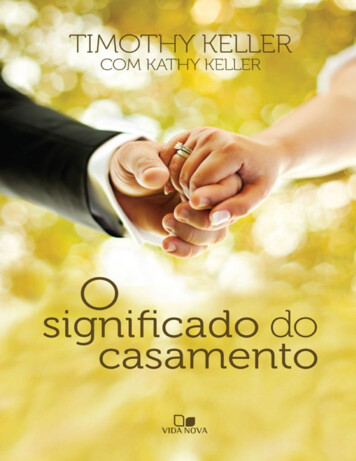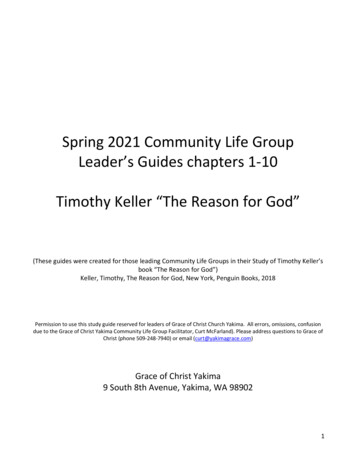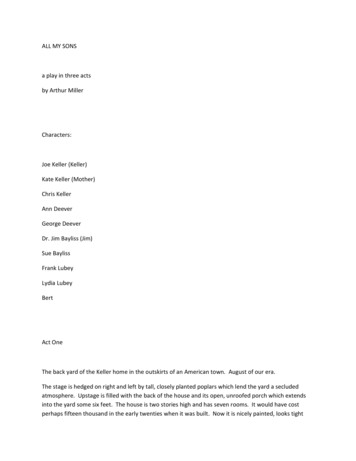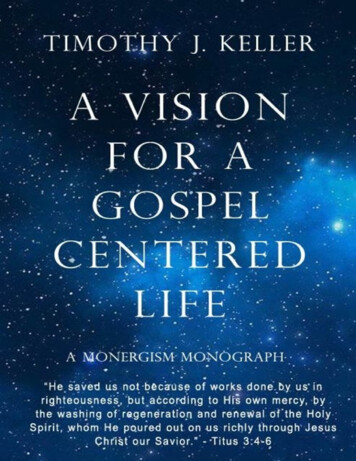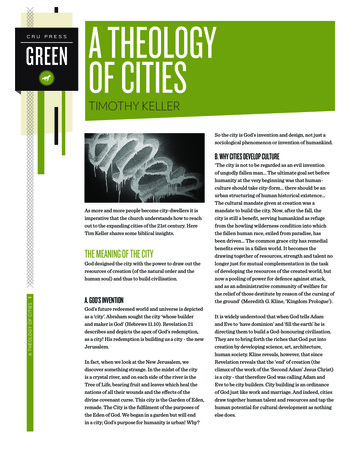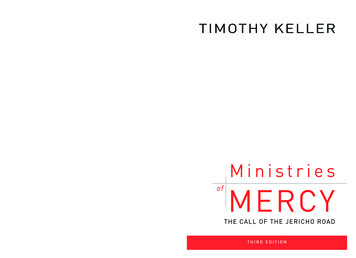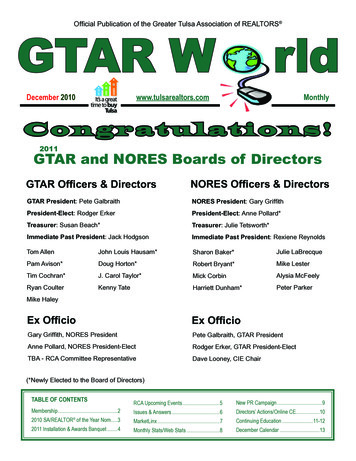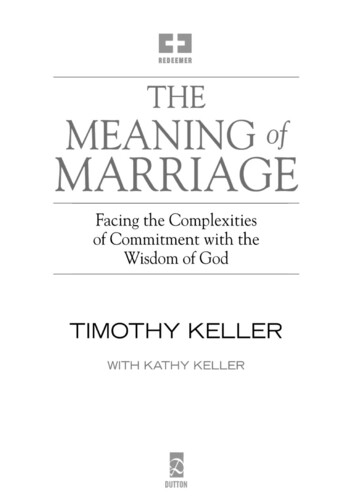
Transcription
ALSO BY TIMOTHY KELLERTHE REASON FOR GOD: Belief in an Age of SkepticismTHE PRODIGAL GOD: Recovering the Heart of theChristian FaithCOUNTERFEIT GODS: The Empty Promises of Money, Sex,and Power, and the Only Hope That MattersGENEROUS JUSTICE: How God’s Grace Makes Us JustKING’S CROSS: The Story of the World in the Life of Jesus
THEMEANING of MARRIAGEFacing the Complexities ofCommitment with the Wisdom ofGodTIMOTHY KELLERWITH KATHY KELLERDUTTON
DUTTONPublished by Penguin Group (USA) Inc.375 Hudson Street, New York, New York 10014, U.S.A.Penguin Group (Canada), 90 Eglinton Avenue East, Suite 700, Toronto, Ontario M4P 2Y3, Canada (adivision of Pearson Penguin Canada Inc.); Penguin Books Ltd, 80 Strand, London WC2R 0RL, England;Penguin Ireland, 25 St Stephen’s Green, Dublin 2, Ireland (a division of Penguin Books Ltd); PenguinGroup (Australia), 250 Camberwell Road, Camberwell, Victoria 3124, Australia (a division of PearsonAustralia Group Pty Ltd); Penguin Books India Pvt Ltd, 11 Community Centre, Panchsheel Park, NewDelhi—110 017, India; Penguin Group (NZ), 67 Apollo Drive, Rosedale, Auckland 0632, New Zealand (adivision of Pearson New Zealand Ltd); Penguin Books (South Africa) (Pty) Ltd, 24 Sturdee Avenue,Rosebank, Johannesburg 2196, South AfricaPenguin Books Ltd, Registered Offices: 80 Strand, London WC2R 0RL, EnglandPublished by Dutton, a member of Penguin Group (USA) Inc.First printing, November 2011Copyright 2011 by Timothy Keller and Kathy KellerAll rights reservedREGISTERED TRADEMARK—MARCA REGISTRADALIBRARY OF CONGRESS CATALOGING-IN-PUBLICATION DATAKeller, Timothy J., 1950–The meaning of marriage : facing the complexities of commitment with the wisdomof God / Timothy Keller with Kathy Keller.—1st ed.p. cmIncludes bibliographical references and index.ISBN 978-1-101-54804-21. Marriage—Religious aspects—Christianity. I. Keller, Kathy (Kathy Louise)II. Title III. Title: Facing the complexities of commitment with the wisdom of God.BV835. K455 2011248.8’ 44—dc232011032434Designed by Leonard TelescaWithout limiting the rights under copyright reserved above, no part of this publication may be reproduced,stored in or introduced into a retrieval system, or transmitted, in any form, or by any means (electronic,mechanical, photocopying, recording, or otherwise), without the prior written permission of both thecopyright owner and the above publisher of this book.The scanning, uploading, and distribution of this book via the Internet or via any other means without thepermission of the publisher is illegal and punishable by law. Please purchase only authorized electroniceditions, and do not participate in or encourage electronic piracy of copyrighted materials. Your support ofthe author’s rights is appreciated.While the author has made every effort to provide accurate telephone numbers and Internet addresses at thetime of publication, neither the publisher nor the author assumes any responsibility for errors, or forchanges that occur after publication. Further, the publisher does not have any control over and does notassume any responsibility for authoror third-party websites or their content.
To Our Friends for Four DecadesOur journeys have taken us to different placesbut never away from one another,or from each other,or from our First LoveAdele and Doug CalhounJane and Wayne FrazierLouise and David MidwoodGayle and Gary SomersCindy and Jim Widmer
CONTENTSINTRODUCTIONONETHE SECRET OF MARRIAGETWOTHE POWER FOR MARRIAGETHREETHE ESSENCE OF MARRIAGEFOURTHE MISSION OF MARRIAGEFIVELOVING THE STRANGERSIXEMBRACING THE OTHERSEVENSINGLENESS AND MARRIAGEEIGHTSEX AND MARRIAGEEPILOGUEAPPENDIX: DECISION MAKING AND GENDERROLES
INTRODUCTIONGod, the best maker of all marriages,Combine your hearts in one.—William Shakespeare, Henry VA Book for Married PeopleThink of this book as a tree supplied by three deep roots. Thefirst is my thirty-seven-year marriage to my wife, Kathy.1 Shehelped me write this book, and she herself wrote chapter 6,Embracing the Other. In chapter 1, I caution readers about theway contemporary culture defines “soul mate” as “a perfectlycompatible match.” Nevertheless, when we first began tospend time with each other, we each realized that the other wasa rare fit for our hearts. I first met Kathy through her sister,Susan, who was a student with me at Bucknell University.Susan often spoke to Kathy about me and to me about Kathy.As a young girl, Kathy had been led toward the Christian faithby C. S. Lewis’s The Chronicles of Narnia.2 She urged Susanto recommend them to me. I read and was moved by the booksand by other Lewis volumes that I subsequently studied. In1972, we both enrolled at the same school, Gordon-ConwellTheological Seminary on Boston’s North Shore, and there wequickly came to see that we shared the “secret thread” thatLewis says is the thing that turns people into close friends—ormore.You may have noticed that the books you really loveare bound together by a secret thread. You knowvery well what is the common quality that makesyou love them, though you cannot put it intowords:. . . . Are not all lifelong friendships born atthe moment when at last you meet another humanbeing who has some inkling . . . of that somethingwhich you were born desiring . . . ?3
Our friendship grew into romance and engagement, andthen from a fragile new marriage into a tested and durable one.But this only happened through the “pearls before swine”speech, the Great Dirty Diaper Conflict, the “smashing thewedding china” affair, and other infamous events in our familyhistory that will be described in this book—all mileposts onthe very bumpy road to marital joy. Like most young moderncouples, we found that marriage was much harder than weexpected it to be. At the conclusion of our wedding ceremony,we marched out singing to the hymn “How Firm aFoundation.” Little did we know how relevant some of thelines would be to the arduous and painful work of developinga strong marriage.When through fiery trials, thy pathway shall lie,My grace all-sufficient will be thy supply.For I will be with thee, thy troubles to blessAnd sanctify to thee thy deepest distress.4This book, therefore, is for those spouses who havediscovered how challenging day-to-day marriage is and whoare searching for practical resources to survive the sometimesoverwhelming “fiery trials” of matrimony and to grow throughthem. Our society’s experience with marriage has given us themetaphor “the honeymoon is over.” This is a book for thosewho have experienced this as a literal truth and may havefallen back to earth with a thud.A Book for Unmarried PeopleThe second source for this book is a long pastoral ministry in acity with millions (and a church with thousands) of singleadults. Our congregation, Redeemer Presbyterian Church inManhattan, is a rarity—a very large church that has been foryears composed predominantly of singles. Several years ago,when we had about four thousand people in attendance, Iasked a very prominent church consultant, “How manychurches do you know of our size with three thousand
singles?” He answered, “Your church is unique, as far as Iknow.”Ministering in the center of New York City in the late1980s, Kathy and I were constantly struck by the deepambivalence with which Western culture views marriage. Itwas then we began to hear all the now society-wide objections—marriage was originally about property and is now in flux,marriage crushes individual identity and has been oppressivefor women, marriage stifles passion and is ill-fitted topsychological reality, marriage is “just a piece of paper” thatonly serves to complicate love, and so on. But beneath thesephilosophical objections lies a snarl of conflicted personalemotions, born out of many negative experiences withmarriage and family life.Early in our New York City ministry, in the fall of 1991, Ipreached a nine-week series on marriage. It has since been themost listened-to set of sermons or talks the church has everproduced. I had to begin the series by giving some justificationfor devoting weeks of teaching on being married to acongregation of mainly unmarried people. My main rationalewas that single people today need a brutally realistic yetglorious vision of what marriage is and can be. What I saidthen fits single readers today, and this book is for them, too.In preparation for writing this, I read a host of Christianbooks on marriage. Most of them were written to help marriedcouples work through specific problems. This volume will beuseful for that as well, but its primary goal is to give bothmarried and unmarried people a vision for what marriage isaccording to the Bible. That will help married people correctmistaken views that might be harming their marriage, and itwill help single people stop destructively over-desiringmarriage or destructively dismissing marriage altogether. Also,a Bible-based marriage book will help each reader have abetter idea of who he or she should consider as a prospectivemate.A Book about the Bible
There is a third source for the material in this book, and it isthe most foundational. Though this book is rooted in mypersonal experience of marriage and ministry, it is even moregrounded in the teachings of the Old and New Testaments.Nearly four decades ago, as theological students, Kathy and Istudied the Biblical teachings on sex, gender, and marriage.Over the next fifteen years, we worked them out in our ownmarriage. Then, over the last twenty-two years, we have usedwhat we learned from both Scripture and experience to guide,encourage, counsel, and instruct young urban adults withregard to sex and marriage. We offer the fruit of these threeinfluences to you in this book.But the foundation of it all is the Bible.In the Bible there are three human institutions that standapart from all others—the family, the church, and the state.There’s nothing in the Bible about how schools should be run,even though they are crucial to a flourishing society. There’snothing there about business corporations or museums orhospitals. In fact, there are all sorts of great institutions andhuman enterprises that the Bible doesn’t address or regulate.And so we are free to invent them and operate them in linewith the general principles for human life that the Bible givesus.But marriage is different. As the Presbyterian Book ofCommon Worship says, God “established marriage for thewelfare and happiness of humankind.” Marriage did notevolve in the late Bronze Age as a way to determine propertyrights. At the climax of the Genesis account of creation we seeGod bringing a woman and a man together to unite them inmarriage. The Bible begins with a wedding (of Adam and Eve)and ends in the book of Revelation with a wedding (of Christand the church). Marriage is God’s idea. It is certainly also ahuman institution, and it reflects the character of the particularhuman culture in which it is embedded. But the concept androots of human marriage are in God’s own action, andtherefore what the Bible says about God’s design for marriageis crucial.
That is why the Presbyterian service of marriage says thatmarriage is “instituted by God, regulated by hiscommandments, blessed by our Lord Jesus Christ.” What Godinstitutes he also regulates. If God invented marriage, thenthose who enter it should make every effort to understand andsubmit to his purposes for it. We do this in many other aspectsof our lives. Think of buying a car: If you purchase a vehicle, amachine well beyond your own ability to create, you willcertainly take up the owner’s manual and abide by what thedesigner says the car needs by way of treatment andmaintenance. To ignore it would be to court disaster.Plenty of people who do not acknowledge God or the Bible,yet who are experiencing happy marriages, are largely abidingby God’s intentions, whether they realize it or not. But it is farbetter if we are conscious of those intentions. And the place todiscover them is in the writings of the Scripture.What if you want to read this book and you don’t share theassumption that the Bible is the authoritative revelation fromGod? Maybe you appreciate the Bible in some regards, butyou don’t trust it on the subjects of sex, love, and marriage.These topics of ancient wisdom are at great variance withcontemporary Western sensibilities, and therefore the Biblehas a reputation for being “regressive” on those subjects. Wewould urge you give this book a try anyway. Over the yearsboth Kathy and I have taught at length on marriage, and I havespoken on marriage at innumerable weddings. There we’velearned that most people who do not share our view of theBible or even our Christian faith are often shocked by howpenetrating the Biblical perspective on marriage is and howrelevant it is to their own situations. So often people have toldme after the ceremony, “I’m not religious at all, but that wasthe most helpful and practical explanation of marriage I’veever heard.”It is hard to get a good perspective on marriage. We all see itthrough the inevitably distorted lenses of our own experience.If you came from an unusually stable home, where your parents had a great marriage, that may have “made it look easy”
toyou, and so when you get to your own marriage you may beshocked by how much it takes to forge a lasting relationship.On the other hand, if you have experienced a bad marriage or adivorce, either as a child or an adult, your view of marriagemay be overly wary and pessimistic. You may be tooexpectant of relationship problems and, when they appear, betoo ready to say, “Yup, here it goes,” and to give up. In otherwords, any kind of background experience of marriage maymake you ill equipped for it yourself.So where can you go for a comprehensive view ofmarriage? There are many good “how-to” volumes usuallywritten by counselors that can be very helpful. In a few years,however, marriage manuals look dated. In the Bible you haveteaching that has been tested by millions of people overcenturies and in multiple cultures. Do we have any otherresource on marriage like that?The Plan of the BookThe substance of this book draws on St. Paul’s great passageon marriage in Ephesians 5, not only because it is so rich andfull in itself, but also because it connects and expounds on theother most important Biblical text on marriage, Genesis 2. Inchapter 1, we put Paul’s discussion into today’s culturalcontext and lay out two of the most basic teachings by theBible on marriage—that it has been instituted by God and thatmarriage was designed to be a reflection of the saving love ofGod for us in Jesus Christ. That is why the gospel helps us tounderstand marriage and marriage helps us to understand thegospel. In chapter 2, we present Paul’s thesis that all marriedpartners need the work of the Holy Spirit in their lives. Thework of the Spirit makes Christ’s saving work real to ourhearts, giving us supernatural help against the main enemy ofmarriage: sinful self-centeredness. We need the fullness of theSpirit if we are to serve one another as we should.Chapter 3 gets us into the heart of what marriage is all about—namely, love. But what is love? This chapter discusses the
relationship of feelings of love to acts of love and therelationship of romantic passion to covenantal commitment.Chapter 4 addresses the question of what marriage is for: It isa way for two spiritual friends to help each other on theirjourney to become the persons God designed them to be. Herewe will see that a new and deeper kind of happiness is foundon the far side of holiness. Chapter 5 lays out three basic skillsets with which we can help each other on that journey.Chapter 6 discusses the Christian teaching that marriage is aplace where the two sexes accept each other as differentlygendered and learn and grow through it. Chapter 7 helps singlepeople use the material in this book to live the single life welland to think wisely about seeking marriage themselves.Finally, chapter 8 takes on the subject of sex, why the Bibleconfines it to marriage, and how, if we embrace the Biblicalview, it will play out in both the single life and in marriage.5In this book we examine the Christian understanding ofmarriage. It is based, as we have said, on a straightforwardreading of Biblical texts. This means we are defining marriageas a lifelong, monogamous relationship between a man and awoman. According to the Bible, God devised marriage toreflect his saving love for us in Christ, to refine our character,to create stable human community for the birth and nurture ofchildren, and to accomplish all this by bringing thecomplementary sexes into an enduring whole-life union. Itneeds to be said, therefore, that this Christian vision formarriage is not something that can be realized by two peopleof the same sex. That is the unanimous view of the Biblicalauthors, and therefore that is the view that we assumethroughout the rest of this book, even though we don’t directlyaddress the subject of homosexuality.The Bible’s teaching on marriage does not merely reflect theperspective of any one culture or time. The teachings ofScripture challenge our contemporary Western culture’snarrative of individual freedom as the only way to be happy.At the same time, it critiques how traditional cultures perceivethe unmarried adult to be less than a fully formed human
being. The book of Genesis radically critiques the institutionof polygamy, even though it was the accepted cultural practiceof the time, by vividly depicting the misery and havoc it playsin family relationships, and the pain it caused, especially forwomen. The New Testament writers, in a way that startled thepagan world, lifted up long-term singleness as a legitimateway to live.6 In other words, the Biblical authors’ teachingconstantly challenged their own cultures’ beliefs—they werenot simply a product of ancient mores and practices. Wecannot, therefore, write off the Biblical view of marriage asone-dimensionally regressive or culturally obsolete. On thecontrary, it is bristling with both practical, realistic insightsand breathtaking promises about marriage. And they come notonly in well-stated propositions but also through brilliantstories and moving poetry.7 Unless you’re able to look atmarriage through the lens of Scripture instead of through yourown fears or romanticism, through your particular experience,or through your culture’s narrow perspectives, you won’t beable to make intelligent decisions about your own maritalfuture.
Ephesians 5:18–33(New International Version—1984)18Do not get drunk on wine, which leads todebauchery. Instead, be filled with the Spirit.19Speak to one another with psalms, hymns andspiritual songs. Sing and make music in your heartto the Lord,20 always giving thanks to God theFather for everything, in the name of our Lord JesusChrist.21 Submit to one another out of reverence forChrist.22Wives, submit to your husbands as to the Lord.23For the husband is the head of the wife as Christ isthe head of the church, his body, of which he is theSavior.24 Now as the church submits to Christ, soalso wives should submit to their husbands ineverything.25Husbands, love your wives, just as Christ lovedthe church and gave himself up for her26 to make herholy, cleansing her by the washing with waterthrough the word,27 and to present her to himself asa radiant church, without stain or wrinkle or anyother blemish, but holy and blameless.28 In this sameway, husbands ought to love their wives as their ownbodies. He who loves his wife loves himself.29 Afterall, no one ever hated his own body, but he feeds andcares for it, just as Christ does the church30—for weare members of his body.31 “For this reason a manwill leave his father and mother and be united to hiswife, and the two will become one flesh.”32 This is aprofound mystery—but I am talking about Christand the church.33 However, each one of you alsomust love his wife as he loves himself, and the wifemust respect her husband.
ONETHE SECRET OF MARRIAGEA man shall leave his father and mother and be united to his wife, and the two willbecome one flesh. This is a profound mystery. . . .Ephesians 5:31–32I’m tired of listening to sentimental talks on marriage. At weddings, in church, and in Sundayschool, much of what I’ve heard on the subject has as much depth as a Hallmark card. Whilemarriage is many things, it is anything but sentimental. Marriage is glorious but hard. It’s aburning joy and strength, and yet it is also blood, sweat, and tears, humbling defeats andexhausting victories. No marriage I know more than a few weeks old could be described as afairy tale come true. Therefore, it is not surprising that the only phrase in Paul’s famousdiscourse on marriage in Ephesians 5 that many couples can relate to is verse 32, printedabove. Sometimes you fall into bed, after a long, hard day of trying to understand each other,and you can only sigh: “This is all a profound mystery!” At times, your marriage seems to bean unsolvable puzzle, a maze in which you feel lost.I believe all this, and yet there’s no relationship between human beings that is greater ormore important than marriage. In the Bible’s account, God himself officiates at the firstwedding (Genesis 2:22–25). And when the man sees the woman, he breaks into poetry andexclaims, “At last!”1 Everything in the text proclaims that marriage, next to our relationshipto God, is the most profound relationship there is. And that is why, like knowing God himself,coming to know and love your spouse is difficult and painful yet rewarding and wondrous.The most painful, the most wonderful—this is the Biblical understanding of marriage, andthere has never been a more important time to lift it up and give it prominence in our culture.The Decline of MarriageOver the last forty years, the “leading marriage indicators”—empirical descriptions ofmarriage health and satisfaction in the United States—have been in steady decline.2 Thedivorce rate is nearly twice the rate it was in 1960.3 In 1970, 89 percent of all births were tomarried parents, but today only 60 percent are.4 Most tellingly, over 72 percent of Americanadults were married in 1960, but only 50 percent were in 2008.5All of this shows an increasing wariness and pessimism about marriage in our culture, andthis is especially true of younger adults. They believe their chances of having a good marriageare not great, and, even if a marriage is stable, there is in their view the horrifying prospectthat it will become sexually boring. As comedian Chris Rock has asked, “Do you want to besingle and lonely or married and bored?” Many young adults believe that these are indeed thetwo main options. That is why many aim for something in the middle between marriage andmere sexual encounters—cohabitation with a sexual partner.This practice has grown exponentially in the last three decades. Today more than half of allpeople live together before getting married. In 1960, virtually no one did.6 One quarter of allunmarried women between the ages of twenty-five and thirty-nine are currently living with apartner, and by their late thirties over 60 percent will have done so.7 Driving this practice areseveral widespread beliefs. One is the assumption that most marriages are unhappy. After all,the reasoning goes, 50 percent of all marriages end in divorce, and surely many of the other50 percent must be miserable. Living together before marriage, many argue, improves yourchances of making a good marriage choice. It helps you discover whether you are compatiblebefore you take the plunge. It’s a way to discover if the other person can really keep yourinterest, if the “chemistry” is strong enough. “Everyone I know who’s gotten married quickly—and failed to live together [first]—has gotten divorced,” said one man in a Gallup surveyfor the National Marriage Project.8
The problem with these beliefs and assumptions, however, is that every one of them isalmost completely wrong.The Surprising Goodness of MarriageDespite the claim of the young man in the Gallup survey, “a substantial body of evidenceindicates that those who live together before marriage are more likely to break up aftermarriage.”9 Cohabitation is an understandable response from those who experienced theirown parents’ painful divorces, but the facts indicate that the cure may be worse than thealleged disease.10Other common assumptions are wrong as well. While it is true that some 45 percent ofmarriages end in divorce, by far the greatest percentage of divorces happen to those whomarry before the age of eighteen, who have dropped out of high school, and who have had ababy together before marrying. “So if you are a reasonably well-educated person with adecent income, come from an intact family and are religious, and marry after twenty-fivewithout having a baby first, your chances of divorce are low indeed.”11Many young adults argue for cohabitation because they feel they should own a home andbe financially secure before they marry.12 The assumption is that marriage is a financial drain.But studies point to what have been called “The Surprising Economic Benefits ofMarriage.”13 A 1992 study of retirement data shows that individuals who were continuouslymarried had 75 percent more wealth at retirement than those who never married or whodivorced and did not remarry. Even more remarkably, married men have been shown to earn10–40 percent more than do single men with similar education and job histories.Why would this be? Some of this is because married people experience greater physicaland mental health. Also, marriage provides a profound “shock absorber” that helps younavigate disappointments, illnesses, and other difficulties. You recover your equilibriumfaster. But the increased earnings probably also come from what scholars call “marital socialnorms.” Studies show that spouses hold one another to greater levels of personalresponsibility and self-discipline than friends or other family members can. Just to give oneexample, single people can spend money unwisely and self-indulgently without anyone tohold them accountable. But married people make each other practice saving, investment, anddelayed gratification. Nothing can mature character like marriage.14Perhaps the main reason that young adults are wary of marriage is their perception thatmost couples are unhappy in their marriages. Typical is a Yahoo! Forum in which a twentyfour-year-old male announced his decision to never marry. He reported that as he had sharedhis decision over the past few months to his married friends, everyone laughed and actedjealous. They all said to him that he was smart. He concluded that at least 70 percent ofmarried people must be unhappy in their relationships. A young woman in a response to hispost agreed with his anecdotal evidence. That fit her own assessment of her married friends.“Out of 10 married couples . . . 7 are miserable as hell,” she opined, and added, “I’m gettingmarried next year because I love my fiancé. However, if things change, I won’t hesitate todivorce him.”15Recently the New York Times Magazine ran an article about a new movie called Monogamyby Dana Adam Shapiro.16 In 2008, Shapiro came to realize that many of his married thirtysomething friends were breaking up. In preparation for making a film about it, he decided todo an oral history of breaking up—collecting fifty in-depth interviews with people who hadseen their marriages dissolve. He did no research, however, on happy, long-term marriages.When asked why he did not do that, he paraphrased Tolstoy: “All happy couples are the same.Which is to say they’re just boring.”17 “So it will not be surprising,” the Times reporterconcluded, “to say that the film, in the end, takes a grim, if not entirely apocalyptic, view ofrelationships.” The movie depicts two people who love each other very much but who simply“can’t make it work.” In other interviews about the movie, the filmmaker expresses his belief
that it is extraordinarily hard though not completely impossible for two modern persons tolove each other without stifling one another’s individuality and freedom. In the reporter’swords, the never-married Shapiro, though he hopes to be married someday and does notbelieve his film is anti-marriage, finds an “intractable difficulty” with monogamy. In this hereflects the typical view of young adults, especially in the more urban areas of the UnitedStates.As the pastor of a church containing several thousand single people in Manhattan, I havetalked to countless men and women who have the same negative perceptions about marriage.However, they underestimate the prospects for a good marriage. All surveys tell us that thenumber of married people who say they are “very happy” in their marriages is high—about61–62 percent—and there has been little decrease in this figure during the last decade. Moststriking of all, longitudinal studies demonstrate that two-thirds of those unhappy marriagesout there will become happy within five years if people stay married and do not getdivorced.18 This led University of Chicago sociologist Linda J. Waite to say, “the benefits ofdivorce have been oversold.”19During the last two decades, the great preponderance of research evidence shows thatpeople who are married consistently show much higher degrees of satisfaction with their livesthan those who are single, divorced, or living with a partner.20 It also reveals that most peopleare happy in their marriages, and most of those who are not and who don’t get divorcedeventually become happy. Also, children who grow up in married, two-parent families havetwo to three times more positive life outcomes than those who do not.21 The overwhelmingverdict, then, is that being married and growing up with parents who are married areenormous boosts to our well-being.The History of MarriageBelief in the desirability and goodness of marriage was once universal, but that
of God / Timothy Keller with Kathy Keller.—1st ed. p. cm Includes bibliographical references and index. . —marriage was originally about property and is now in flux, . most listened-to set of sermon
